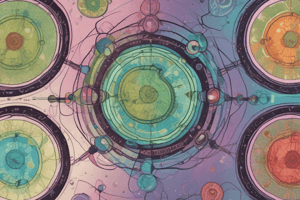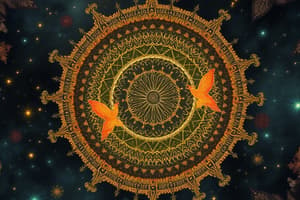Podcast
Questions and Answers
¿Cuál es la fase más larga del ciclo celular?
¿Cuál es la fase más larga del ciclo celular?
- Citocinesis
- Profase
- Mitosis
- Interfase (correct)
¿Cuáles son las tres subfases de la interfase?
¿Cuáles son las tres subfases de la interfase?
- Profase, Metafase, Telofase
- Anafase, Telofase, Citocinesis
- G1, S, G2 (correct)
- G1, G2, M
¿Qué ocurre durante la profase de la mitosis?
¿Qué ocurre durante la profase de la mitosis?
- Los cromosomas se alinean en el centro de la célula
- Los cromosomas se separan y se mueven hacia los polos opuestos de la célula
- La envoltura nuclear se rompe y se forman las fibras del huso (correct)
- La citocinesis divide el citoplasma en dos células hijas
¿Cuál es el resultado final de la mitosis?
¿Cuál es el resultado final de la mitosis?
¿Cuál es el propósito principal de la citocinesis?
¿Cuál es el propósito principal de la citocinesis?
¿Qué función cumplen los puntos de control del ciclo celular?
¿Qué función cumplen los puntos de control del ciclo celular?
¿Qué proceso se refiere específicamente a la separación física del citoplasma para producir células hijas separadas después de la mitosis?
¿Qué proceso se refiere específicamente a la separación física del citoplasma para producir células hijas separadas después de la mitosis?
En las células animales, ¿qué estructura se forma durante la citocinesis para constreñir y dividir la célula?
En las células animales, ¿qué estructura se forma durante la citocinesis para constreñir y dividir la célula?
En las células vegetales, ¿qué mecanismo conduce a la separación eventual de las células hijas durante la citocinesis?
En las células vegetales, ¿qué mecanismo conduce a la separación eventual de las células hijas durante la citocinesis?
¿Qué fase del ciclo celular se encarga de la síntesis de ADN?
¿Qué fase del ciclo celular se encarga de la síntesis de ADN?
¿Qué proteínas reguladoras se unen a las quinasas dependientes de ciclinas para activar o inhibir su actividad?
¿Qué proteínas reguladoras se unen a las quinasas dependientes de ciclinas para activar o inhibir su actividad?
¿Qué ciclina controla la entrada en la mitosis, asegurando los puntos de control adecuados para la segregación precisa del ADN?
¿Qué ciclina controla la entrada en la mitosis, asegurando los puntos de control adecuados para la segregación precisa del ADN?
Flashcards are hidden until you start studying
Study Notes
Cell Cycle
The cell cycle is a series of events that occur when a cell grows and prepares to divide into two identical daughter cells. It consists of three main phases: interphase and two division stages - cytokinesis and mitosis.
Interphase
Interphase is the longest phase of the cell cycle and occurs between each round of mitosis, during which DNA replication and cell growth take place. Interphase itself has three distinct subphases: Gap 1 (G1), Synthesis (S), and Gap 2 (G2). During this stage, the cell synthesizes proteins and RNA necessary for future division cycles and also duplicates its genetic material.
Mitosis
Mitosis is the process by which a single diploid cell divides into two genetically identical daughter cells, with one copy of each chromosome per cell. This process involves four key stages - prophase, metaphase, anaphase, and telophase. Prophase marks the beginning of mitosis, where the nuclear envelope breaks down, spindle fibers form, and chromosomes condense. In metaphase, chromosomes align along the middle of the cell, ready for separation. During anaphase, sister chromatids separate, pulled apart by the spindle fibers, while in telophase, new nuclear envelopes form around the separated chromosomes. Finally, the cytoplasm divides due to contraction of the actomyosin-containing ring known as the cleavage furrow, forming two separate cells.
Cytokinesis
Cytokinesis refers specifically to the physical separation of the cytoplasm to produce separate daughter cells after mitosis. In animal cells, this process begins with the formation of an actomyosin-containing contractile ring around the equatorial region of the dividing cell, which constricts it to pinch off the cell at the midpoint, splitting the cytoplasm. In plant cells, a different mechanism called plasmodesmata closure restricts the passage of cytosol between the incipient cells, leading to their eventual separation.
Regulation of Cell Cycle
Regulating the timing and mode of cell division is crucial to ensure proper tissue development and maintenance. Several factors influence the progression of the cell cycle, including cyclins and cyclin-dependent kinases (CDKs). Cyclins are regulatory proteins that bind to CDKs to activate or inhibit their activity, depending on the specific cyclin involved. For example, cyclin A and E control the onset of S phase, promoting DNA synthesis, while cyclin B controls entry into mitosis, ensuring proper checkpoints for accurate DNA segregation.
In summary, the cell cycle is a complex sequence of events involving interphase, mitosis, and cytokinesis, all regulated by various factors such as cyclins and CDKs. Understanding these processes is fundamental to understanding how life arises from biological materials and how organisms grow and develop.
Studying That Suits You
Use AI to generate personalized quizzes and flashcards to suit your learning preferences.




